Glastonbury, Wells, Bath
Day Two of our trip began with a very pleasant drive from Bath to Glastonbury.
 On our way we passed through beautiful countryside, like here near the village of High Littleton.
On our way we passed through beautiful countryside, like here near the village of High Littleton. This is Glastonbury Tor, as seen driving in to the city of Glastonbury. It is visible from almost everywhere in the city. Legend has it that Joseph of Arimathea came to Glastonbury and buried the Holy Grail near the Tor.
This is Glastonbury Tor, as seen driving in to the city of Glastonbury. It is visible from almost everywhere in the city. Legend has it that Joseph of Arimathea came to Glastonbury and buried the Holy Grail near the Tor. The ruin you see atop the Tor is the 14th century Chapel of St. Michael. The original chapel, built before 1275, was ruined in an earthquake.
The ruin you see atop the Tor is the 14th century Chapel of St. Michael. The original chapel, built before 1275, was ruined in an earthquake.Glastonbury Abbey, seen in the many pictures below, was built by the year 600, then destroyed by fire in 1184.
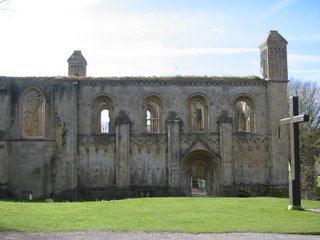 This beautiful ruined building, with most of its walls still standing, is the first thing you see after walking into the grounds. It's the Lady Chapel. It was the first building erected after the fire of 1184.
This beautiful ruined building, with most of its walls still standing, is the first thing you see after walking into the grounds. It's the Lady Chapel. It was the first building erected after the fire of 1184.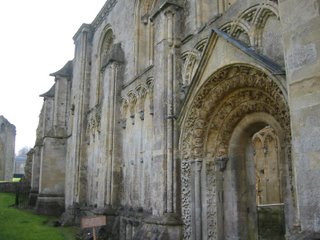 The North Door of the Lady Chapel is intricately carved.
The North Door of the Lady Chapel is intricately carved. This well is situated in the basement of the Lady Chapel. The ornamentation of this well area is identical to that of the windows in the Lady Chapel itself.
This well is situated in the basement of the Lady Chapel. The ornamentation of this well area is identical to that of the windows in the Lady Chapel itself. Here is another view, looking up through the ruin from inside the Lady Chapel.
Here is another view, looking up through the ruin from inside the Lady Chapel.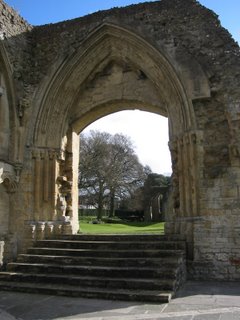 These steps led to the Galilee, or porch, of the Great Church. The Galilee was added in the 14th century.
These steps led to the Galilee, or porch, of the Great Church. The Galilee was added in the 14th century. These are the ruins of the Great Church, built in the early 13th century.
These are the ruins of the Great Church, built in the early 13th century.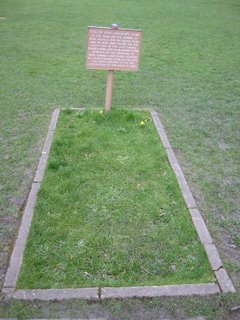 Legend has it that in 1191 monks found the buried remains of King Arthur and Queen Guinevere in the Abbey cemetery. This monument shows where those remains were reburied to great pomp and circumstance (within the church walls) in 1278 by King Edward I and Queen Eleanor.
Legend has it that in 1191 monks found the buried remains of King Arthur and Queen Guinevere in the Abbey cemetery. This monument shows where those remains were reburied to great pomp and circumstance (within the church walls) in 1278 by King Edward I and Queen Eleanor. In this photo, we are standing just outside the Great Church, looking in through the ruined walls.
In this photo, we are standing just outside the Great Church, looking in through the ruined walls.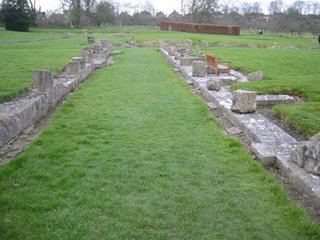 The cloister walls sit to the right of the stones in this picture.
The cloister walls sit to the right of the stones in this picture. This is the Abbot's Kitchen. It is the only building here undestroyed during the Dissolution under Henry VIII, because he needed it, not only as a kitchen, but later as a stable.
This is the Abbot's Kitchen. It is the only building here undestroyed during the Dissolution under Henry VIII, because he needed it, not only as a kitchen, but later as a stable. This view of Glastonbury Tor is taken from the Abbey grounds. When Henry VIII moved to close down the Abbey, he had the Benedictine abbot arrested, tried at the Tor on trumped-up charges of looting from the abbey stores, then executed there.
This view of Glastonbury Tor is taken from the Abbey grounds. When Henry VIII moved to close down the Abbey, he had the Benedictine abbot arrested, tried at the Tor on trumped-up charges of looting from the abbey stores, then executed there.After our tour of Glastonbury, we headed to Wells, the 'smallest city in Britain.' We had heard (and read) that the Cathedral there was beautiful. That turned out to be an understatement.
 Wells is truly a small 'city.' The gate to the Cathedral lies at one end of the Market Square (at the right of this picture).
Wells is truly a small 'city.' The gate to the Cathedral lies at one end of the Market Square (at the right of this picture). When you pass through the gates, you are still not in the cathedral itself. Rather, you see this drawbridge which leads to the Bishop's Palace.
When you pass through the gates, you are still not in the cathedral itself. Rather, you see this drawbridge which leads to the Bishop's Palace.  Here is the moat that surrounds the palace.
Here is the moat that surrounds the palace. 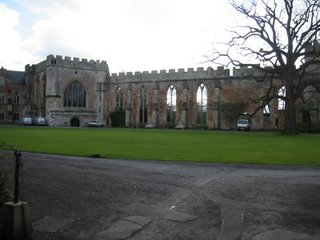 The palace was closed to visitors on that day, so Danny had to take this picture from the gate. To think that Bishops lived (and, apparently, still live) in this kind of luxury!
The palace was closed to visitors on that day, so Danny had to take this picture from the gate. To think that Bishops lived (and, apparently, still live) in this kind of luxury!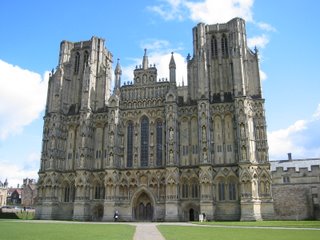 This gorgeous photo shows the West Front of the Cathedral. There are several levels to the carvings on the façade. At the first level, Old Testament scenes can be seen to the right of the doors and New Testament scenes to the left. Above these are statues of saints, then bishops, then kings. Above them are resurrection scenes. At the top, in the center above the angels are the Twelve Apostles. Above the middle apostle, St. Andrew holding the cross, is the reigning Christ.
This gorgeous photo shows the West Front of the Cathedral. There are several levels to the carvings on the façade. At the first level, Old Testament scenes can be seen to the right of the doors and New Testament scenes to the left. Above these are statues of saints, then bishops, then kings. Above them are resurrection scenes. At the top, in the center above the angels are the Twelve Apostles. Above the middle apostle, St. Andrew holding the cross, is the reigning Christ. Here is a close-up of the Apostles on the West Front.
Here is a close-up of the Apostles on the West Front. The Cathedral grounds are also beautiful. This picture is of the Cathedral tower taken from the gardens.
The Cathedral grounds are also beautiful. This picture is of the Cathedral tower taken from the gardens. This is called St. Andrew's Well (whence the city takes its name). The hole in the wall through which the photo was taken is only about ten inches high.
This is called St. Andrew's Well (whence the city takes its name). The hole in the wall through which the photo was taken is only about ten inches high. This stately old tree, inside the cloisters, made an attractive subject for a photograph on this sunny day.
This stately old tree, inside the cloisters, made an attractive subject for a photograph on this sunny day. Here is a spectacular view looking down the nave of the Cathedral.
Here is a spectacular view looking down the nave of the Cathedral. These are the 'scissor arches' that help support the tower above the altar. They were inserted into the building 600 years ago when it was noticed that the pillars under the tower were bowing badly.
These are the 'scissor arches' that help support the tower above the altar. They were inserted into the building 600 years ago when it was noticed that the pillars under the tower were bowing badly.  This is one of many Stone Capitals that decorate the pillars in the Cathedral. The stonecarvers who fashioned them were true artisans. In this scene, a man is trying to remove a thorn from his foot!
This is one of many Stone Capitals that decorate the pillars in the Cathedral. The stonecarvers who fashioned them were true artisans. In this scene, a man is trying to remove a thorn from his foot! The Stations of the Cross mounted along the side aisles, icons painted by some eastern European artists, were gorgeous. Each station, like this one depicting the Crucifixion, was mounted on a very dark wooden plaque that made the colors even more stunning by constrast.
The Stations of the Cross mounted along the side aisles, icons painted by some eastern European artists, were gorgeous. Each station, like this one depicting the Crucifixion, was mounted on a very dark wooden plaque that made the colors even more stunning by constrast. This ancient clock is called the Wells Clock. It is a full 24-hour clock. Its various dials read (working inwards from the outer course) hours, then minutes, then the number of days since the last new moon. In the center is a circular hole in the disk that displays whether the moon is waxing or waning. The knights above the clock race around a little track when the clock chimes every quarter hour.
This ancient clock is called the Wells Clock. It is a full 24-hour clock. Its various dials read (working inwards from the outer course) hours, then minutes, then the number of days since the last new moon. In the center is a circular hole in the disk that displays whether the moon is waxing or waning. The knights above the clock race around a little track when the clock chimes every quarter hour. This little man is called Jack Blandiver. He sits up in a corner to the right of the clock. Jack rings the bells on the quarter hour. We were there for the 2PM chimes.
This little man is called Jack Blandiver. He sits up in a corner to the right of the clock. Jack rings the bells on the quarter hour. We were there for the 2PM chimes. This picture of the organ was taken from the Choir.
This picture of the organ was taken from the Choir.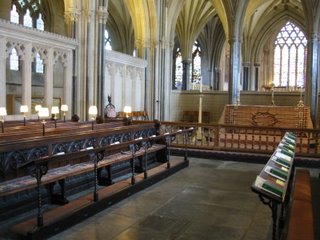 Here is the High Altar.
Here is the High Altar. The Lady Chapel, pictured here, sits behind the High Altar.
The Lady Chapel, pictured here, sits behind the High Altar. These windows, in the Lady Chapel, were beautiful. You can make out a trumpeting angel in the center panel.
These windows, in the Lady Chapel, were beautiful. You can make out a trumpeting angel in the center panel. These architecturally interesting steps, leading up to the Chapter House, were very worn with age.
These architecturally interesting steps, leading up to the Chapter House, were very worn with age. Walking up the stairs to the Chapter House, you pass this lovely stone detail on the wall to the right.
Walking up the stairs to the Chapter House, you pass this lovely stone detail on the wall to the right. The Chapter House was beautiful, and so bright in the sun! It was supported in the center under a column leading up to some gorgeous fan vaulting.
The Chapter House was beautiful, and so bright in the sun! It was supported in the center under a column leading up to some gorgeous fan vaulting. This is the top of this central column. It looks like an enormous flower.
This is the top of this central column. It looks like an enormous flower.Once our tour of Wells Cathedral was finished, we headed back to Bath to do some sightseeing there.
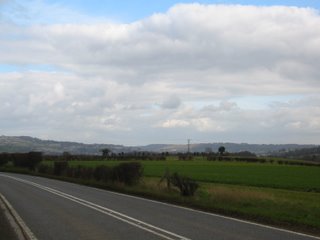 This beautiful view of the countryside was taken along the road to Bath at an inn called the Wheatsheaf, just outside of the village of Corston on the north slopes of the Mendip Hills.
This beautiful view of the countryside was taken along the road to Bath at an inn called the Wheatsheaf, just outside of the village of Corston on the north slopes of the Mendip Hills.After parking the car in Bath, we proceeded on foot to take in some of the sights. What is amazing about Bath is that almost every building is made from the same yellow stone. It makes for striking views wherever you look.
 This is the Jane Austen Center. The famous author lived in Bath for many years and set a few of her novels here. But, wait, there she is at the door to greet us!
This is the Jane Austen Center. The famous author lived in Bath for many years and set a few of her novels here. But, wait, there she is at the door to greet us! Here is one view of the Circus, Britain's first circular street, designed and built by John Wood, Sr. and Jr. in the 1750s-60s.
Here is one view of the Circus, Britain's first circular street, designed and built by John Wood, Sr. and Jr. in the 1750s-60s.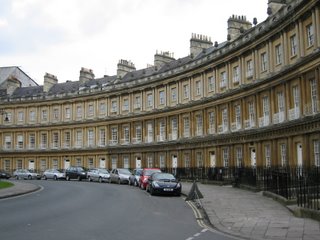 Here is another view of the Circus. Apparently, it was inspired by the Colosseum in Rome. Surrounding the plaza is the great circle of buildings, all connected behind the same façade. Another interesting fact is that the Circus shares the same diameter as Stonehenge!
Here is another view of the Circus. Apparently, it was inspired by the Colosseum in Rome. Surrounding the plaza is the great circle of buildings, all connected behind the same façade. Another interesting fact is that the Circus shares the same diameter as Stonehenge! The Royal Crescent, a block away from the Circus, and in the same Georgian style, was also designed and built by John Wood, Jr.
The Royal Crescent, a block away from the Circus, and in the same Georgian style, was also designed and built by John Wood, Jr. Here is another view of the Royal Crescent.
Here is another view of the Royal Crescent. The buildings you see here are part of the Assembly Rooms. They now house the Museum of Costume.
The buildings you see here are part of the Assembly Rooms. They now house the Museum of Costume. This street is typical of those found in Bath. It is called the Paragon.
This street is typical of those found in Bath. It is called the Paragon.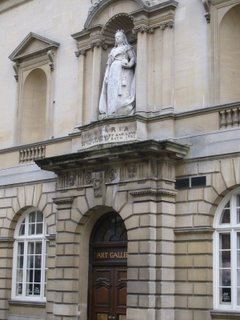 Here is a very lifelike statue of HRH Queen Victoria, standing watch atop the Victoria Art Gallery.
Here is a very lifelike statue of HRH Queen Victoria, standing watch atop the Victoria Art Gallery. Pulteney Bridge, pictured here, spans the River Avon. It consists of many small shops (traditional of medieval times).
Pulteney Bridge, pictured here, spans the River Avon. It consists of many small shops (traditional of medieval times). Here is Bath Abbey, seen from the Grand Parade, the street that follows the River Avon. Just wait until you see the pictures of the front of the Abbey.
Here is Bath Abbey, seen from the Grand Parade, the street that follows the River Avon. Just wait until you see the pictures of the front of the Abbey. Yes, we really DID eat dinner overlooking the River Avon. Isn't life great?
Yes, we really DID eat dinner overlooking the River Avon. Isn't life great?

0 Comments:
Post a Comment
<< Home